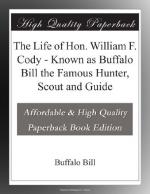But shortly afterwards my attention was attracted by the appearance of a body of soldiers, who were forming into a skirmish line, and then I became convinced that it was General Terry’s command after all, and that the red-skins whom I had seen were some of his friendly Indian scouts, who had mistaken me for a Sioux, and fled back to their command terribly excited, shouting, “The Sioux are coming!”
General Terry at once came to the post, and ordered the Seventh Cavalry to form line of battle across the Rosebud; he also ordered up his artillery and had them prepare for action, doubtless dreading another “Custer massacre.” I afterwards learned the Indians had seen the dust raised by General Crook’s forces, and had reported that the Sioux were coming.
These manoeuvres I witnessed from my position with considerable amusement, thinking the command must be badly demoralized, when one man could cause a whole army to form line of battle and prepare for action. Having enjoyed the situation to my heart’s content, I galloped down towards the skirmish line, waving my hat and when within about one hundred yards of the troops, Colonel Weir, of the Seventh Cavalry, galloped out and met me. He recognized me at once, and accompanied me inside the line; then he sang out, “Boys, here’s Buffalo Bill. Some of you old soldiers know him; give him a cheer!” Thereupon the regiment gave three rousing cheers, and it was followed up all along the line.
Colonel Weir presented me to General Terry, and in answer to his questions I informed him that the alarm of Indians which had been given was a false one, as the dust seen by his scouts was caused by General Crook’s troops. General Terry thereupon rode forward to meet General Crook, and I accompanied him at his request. That night both commands went into camp on the Rosebud. General Terry had his wagon train with him, and everything to make life comfortable on an Indian campaign. He had large wall tents and portable beds to sleep in, and large hospital tents for dining-rooms. His camp looked very comfortable and attractive, and presented a great contrast to that of General Crook, who had for his headquarters only one small fly tent; and whose cooking utensils consisted of a quart cup—in which he made his coffee himself—and a stick, upon which he broiled his bacon. When I compared the two camps, I came to the conclusion that General Crook was an Indian fighter; for it was evident that he had learned that, to follow and fight Indians, a body of men must travel lightly and not be detained by a wagon train or heavy luggage of any kind.
That evening General Terry ordered General Miles to take his regiment, the Fifth Infantry, and return by a forced march to the Yellowstone, and proceed down that river by steamboat to the mouth of Powder river, to intercept the Indians, in case they attempted to cross the Yellowstone. General Mills made a forced march that night of thirty-five miles, which was splendid traveling for an infantry regiment through a mountainous country.




